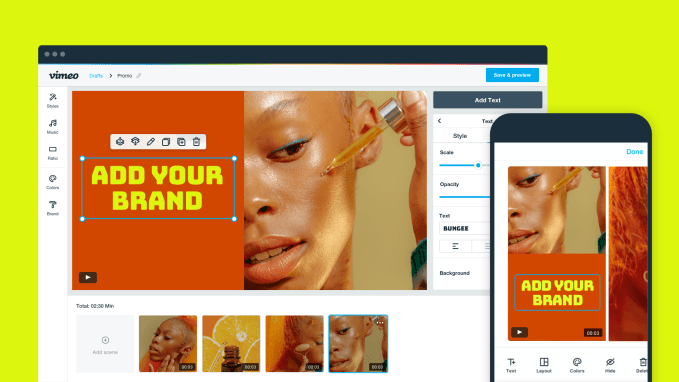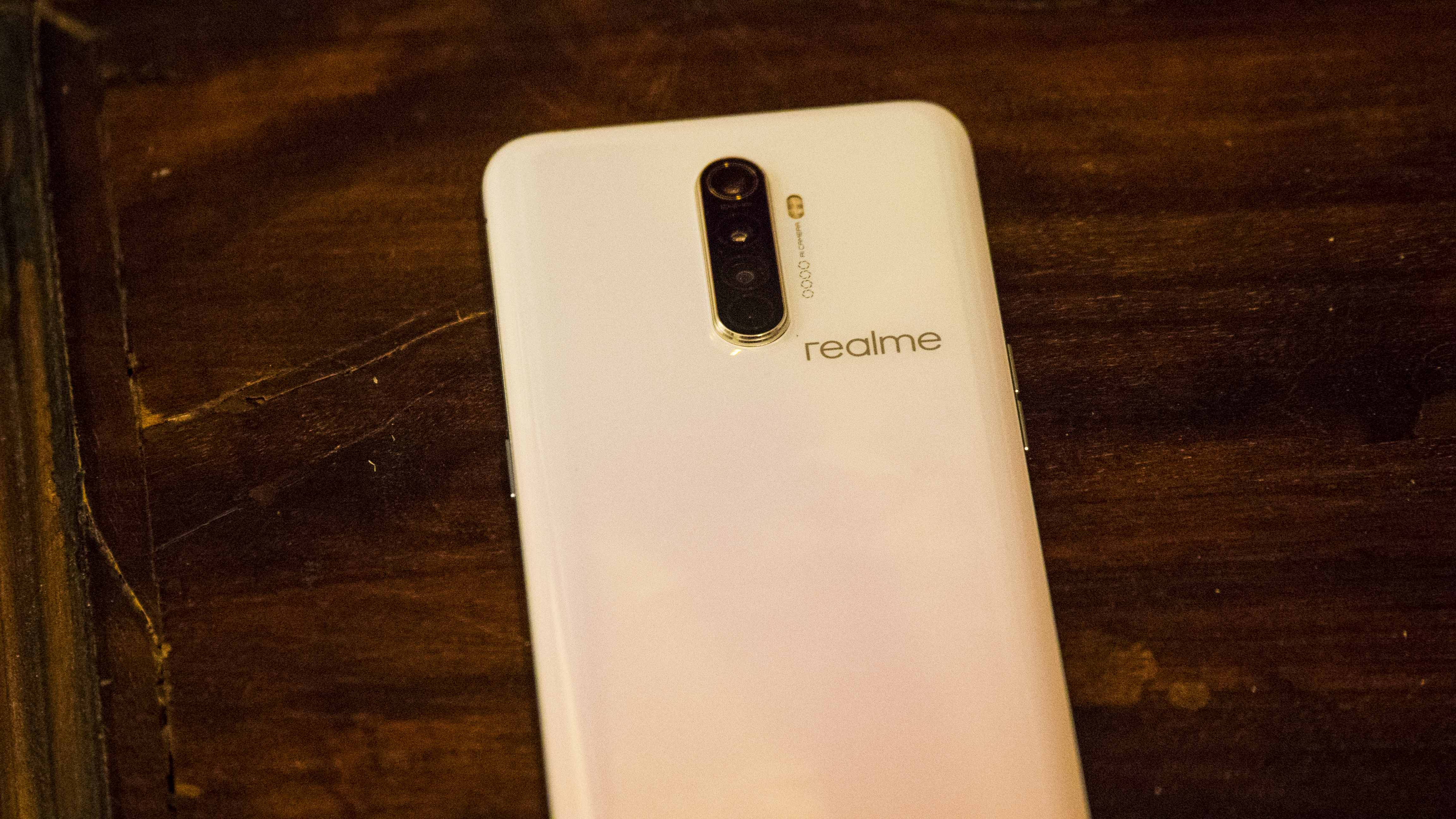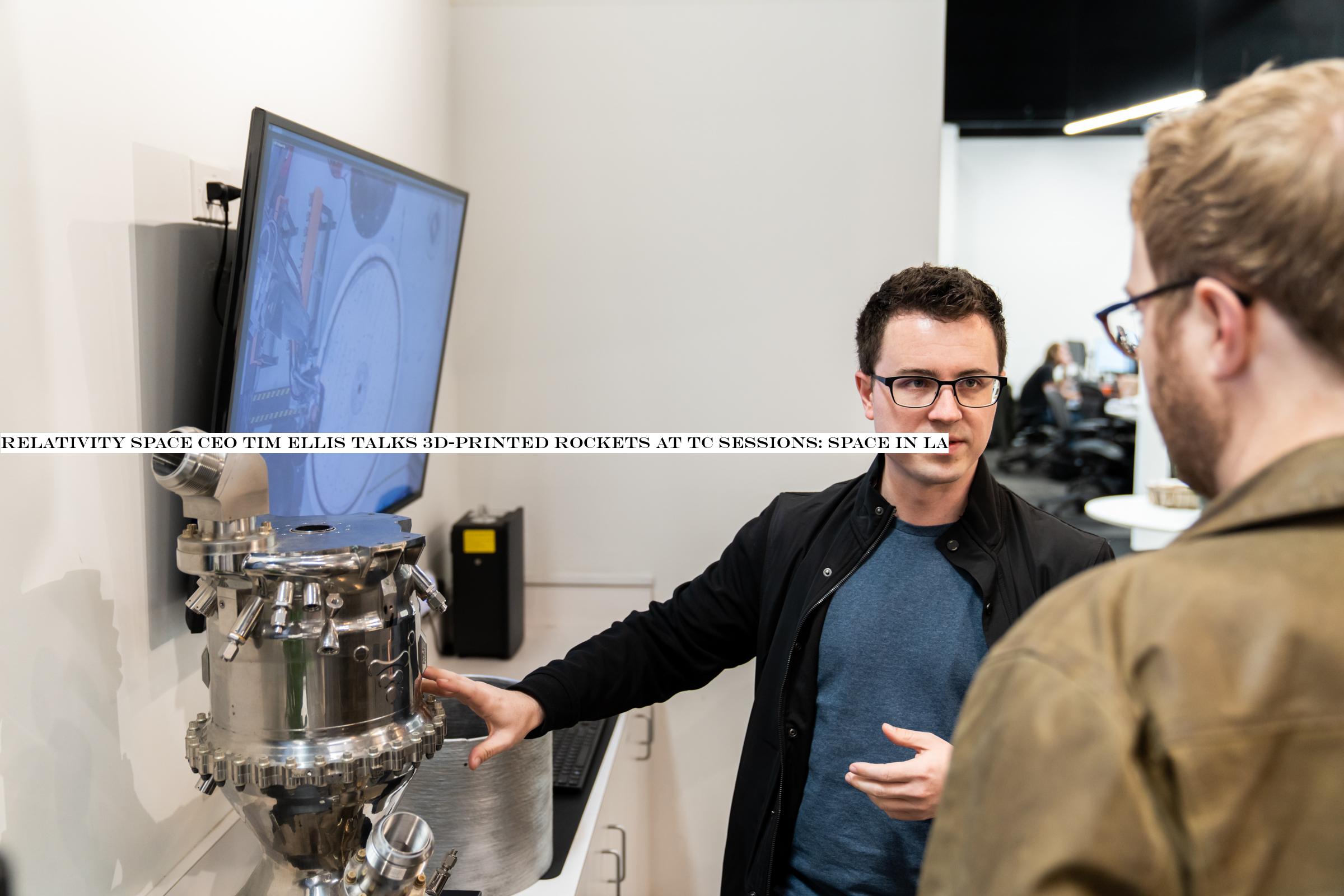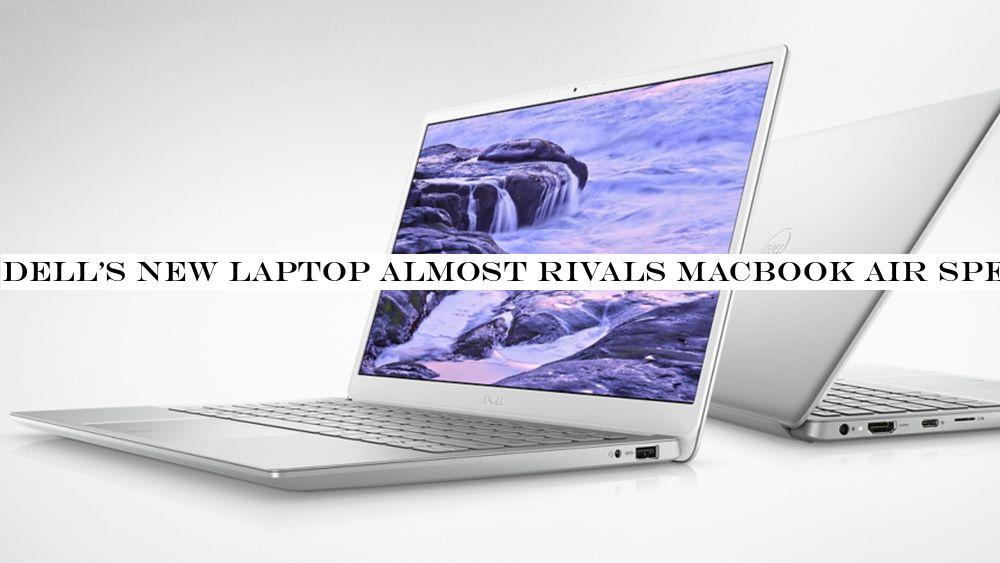Music
Trailers
DailyVideos
India
Pakistan
Afghanistan
Bangladesh
Srilanka
Nepal
Thailand
Iraq
Iran
Russia
Brazil
StockMarket
Business
CryptoCurrency
Technology
Startup
Trending Videos
Coupons
Football
Search
Download App in Playstore
Download App
Best Collections
Technology
Vimeo signaled last year its plans to move further into the social video creation and editing space with its acquisition of short-form video editor Magisto. Today, the company is unveiling the results of its work in the months following the dealclose with the debut of Vimeo Create. The new app includes a set of video creation tools aimed at small businesses and marketers looking to tell their stories using social video, but who lack the resources, time or budget to invest in video production at the scale they need to compete.
With Vimeo Create, available on both the desktop and as an app, businesses choose from pre-made, professionally designed video templates that can be customized to meet their needs. More advanced users could opt to start a new video from scratch, as an alternative.

The app includes a library of stock content to add to videos, including millions of HD video clips, photos and commercially licensed music tracks available for no extra fee, Vimeo says. Businesses also can customize their videos by selecting the colors, fonts, layouts, logos, text captions and calls-to-action they want to use.
The app then leverages AI-powered technology to turn the clips, photos, music and text into a high-quality social video in minutes.
Vimeo Create also simplifies the process of designing videos for different social platforms, where aspect ratios (e.g. square, vertical, horizontal) and format requirements vary. After the video is finalized, users are able to publish across the web — including to Facebook, YouTube, Instagram, Twitter and LinkedIn — as a part of the Vimeo Create workflow.

The move into social video creation is part of Vimeolarger strategy of becoming a one-stop shop for companies and individuals who publish videos online. The company has long since abandoned its plans to be a YouTube competitor, instead seeing the potential in the other side of the video market. Today, Vimeo makes money by offering tools and services to video creators both large and small. It has launched tools for uploading and live streaming across social sites and updated its mobile app to include more features previously available only to desktop users, among other things.
Vimeodecision to prioritize social video resulted from its own research. The company found that only 22% of small business owners felt they were using enough video. The businesses complained that issues around time, cost and complexity were keeping them from going further. Nearly all (96%) of small business owners said they would create more video if all those friction points were removed.
The service was built using parts of Magistobackend and its AI, but the overall app, feature set, content, user interface and integration into Vimeotools were built from the ground up, the company says.

The company hopes Vimeo Create will help it to grow its subscription revenue, as the service is offered as a part of VimeoPro, Business and Premium membership plans, instead of as a standalone paid or freemium app.
&Video is the most impactful medium we have today for human expression at scale, and businesses need an online video strategy to reach their customers. But the research is clear: small business owners and entrepreneurs don&t have the tools, time or budgets to make videos at the volume and quality needed to compete,& said Vimeo CEO Anjali Sud, in a statement about the launch. &Vimeo Create levels the playing field. Ita radically simple tool that shortens the distance from idea to execution, so more businesses can have a successful video strategy.&
Vimeo isn&t alone in addressing the social video needs of small businesses. Last fall, Facetune maker Lightricks launched a full suite of apps for small businesses to use for their social media marketing campaigns. There also are dozens of tools for video editing on the market, including those from incumbents, like Adobe and Apple, as well as from others like Magisto, Canva, PicsArt and many more that offer features craved by small business owners like templates, easy editing tools, access to stock content and support for one-click multi-platform publishing, among other things.
Vimeo first launched Vimeo Create into beta back in January, but today itavailable to all across web, iOS and Android.
- Details
- Category: Technology Today
Read more: Vimeo’s new app helps small businesses create professional social videos
Write comment (93 Comments)

Realme 6 and Realme 6 Pro, along with the Realme band, are set to launch in India on March 5. Realme CEO Madhav Sheth took to twitter and revealed the launch information of the Realme 6 series.
Earlier this week, during the launch of the Realme X50 Pro 5G, the company also revealed that it would be announcing the Realme band fitness tracker on
- Details
- Category: Technology Today
Read more: Realme 6, 6 Pro and Realme band set to launch in India on March 5
Write comment (97 Comments)Silicon Valley air purifier startup Molekule was born out of an idea Dr. Yogi Goswami had back in the &90s using photo-voltaic technology to kill air pollutants. His son, a young boy at the time, suffered from severe allergies and Dr. Goswami wanted to build something those like him could use in their home to clear the air. But the sleekly designed Molekule took a bit of a blow last fall when Wirecutter called it &the worst air purifier we&ve ever tested.&
Molekule has since told TechCrunch comparing its PECO technology to the more common HEPA air filter technology is like comparing apples to oranges. &Up until now, everything has been air filtration, not real air purification,& co-founder and CEO of the company Jaya Rao told TechCrunch.
To disprove the naysayers, Molekule sent off its tech for testing at the Berkeley Lab, which concluded no measurable amount of VOCor ozone were emitted; Molekule effectively removed harmful chemicals in the air, like toluene, limonene, formaldehyde, as well as ozone, and that &no secondary byproducts were observed when the air cleaner was operated in the presence of a challenge VOC mixture.&
Compare that to Wirecutterown assessment that, &on its auto setting, which is its medium setting, the Molekule reduced 0.3-micron particulates by (in the best case) only 26.4 percent over the course of half an hour. Compare that with the 87.6 percent reduction the Coway Mighty achieved on its medium setting.& TechCrunch reached out to Wirecutter and was told it still stands by its findings and does not recommend consumers purchase a Molekule.
It should be noted Consumer Reports also tested the Molekule device and it, too, did not recommend a purchase as the unit was not &proficient at catching larger airborne particles.& However, Molekule demonstrated to other news outlets at its own facilities that the photochemical reaction in its units did break down contaminants and kill mold spores.
&To test PECO technology you actually need really sophisticated equipment,& Rao said. &Boiling it down to really simple factors is not enough because air is made up of many tiny but toxic things. These are airborne chemicals nanometers in size, which Wirecutter admittedly did not test at all for.&
WirecutterTim Heffernan disputes Molekuleclaims of superiority in the category, however. &Now they are comparing apples to oranges,& he told TechCrunch. &The claims about destroying bacteria and viruses, for example, HEPA filters capture them and they capture them permanently.&
So howa consumer to know whatright? First, take into account Molekule commissioned the Berkeley Lab for their independent testing and that Wirecutter and Consumer reports ran their own independent testing. However, it might boil down to understanding the premise of the technology. HEPA filters came out of the Manhattan Project in the 1940s, when scientists needed to develop a filter suitable for removing radioactive materials from the air. It works by capturing and filtering out harmful particles, viruses and mold. However, PECO, the technology in a Molekule unit, uses the science of light to kill mold and bacteria and break down harmful particulates in the air.
Regardless of whether you want an air purifier that captures particulates or breaks them down, Molekule has continued to move forward. The company has since launched a mini unit meant for smaller rooms and started to grow business verticals outside of the direct-to-consumer model, forging partnerships with hotels and hospitals.
It also just announced a raise of $58 million in Series C funding, bringing just over $91 million to its coffers. Rao tells TechCrunch the raise was unexpected, but came out of chats with Samantha Wang from RPS Ventures, which led the round.
&We feel confident in MolekulePECO technology, and have taken an extensive look at the science behind it. It is not only backed by decades of academic research, it has also gone through the peer-reviewed process numerous times, and has been tested and validated by third-party scientists and laboratories across the country,& Wang told TechCrunch.
Other participation in the round included FounderCircle Capital and Inventec Appliances Corp (IAC). Existing investors Foundry Group, Crosslink Capital, Uncork Capital and TransLink Capital also participated in the financing.
Molekule also tells TechCrunch it has seen a healthy growth trajectory in the past year, despite the negative press. According to the company, Molekule has seen a 3x increase in year over year filter subscription revenue since launch, and its repeat customer growth sits at about 200%.
Ita well-designed, though pricier air purification machine with an interesting future in the commercial space, particularly in hospitals, schools, commercial manufacturing and hotels, as Wang points out.
As long as the tech truly makes the air better.
- Details
- Category: Technology Today


As promised, Fujifilm unveiled its latest instant camera alongside the mirrorless powerhouse that is the Fujifilm X-T4.
The Instax Mini 11 looks pretty much like its predecessor, the very popular Instax Mini 9, but adds a few tweaks and comes in five fun colors – Blush Pink, Sky Blue, Charcoal Gray, Ice White and Lilac Purple.
Its physical tweaks
- Details
- Category: Technology Today
Read more: Fujifilm's new Instax Mini 11 perfects the art of close-up selfies
Write comment (99 Comments)
The launch industry is undergoing a number of major changes, among them the shift from traditional manufacturing to 3D printing — which Relativity Space is spearheading. The company plans to build 95% of its rocket using the worldbiggest 3D printers, and could launch as early as next year. Co-founder and CEO Tim Ellis will be on hand at TC Sessions: Space in Los Angeles on June 25 to talk all about it.
Relativity has been on our radar for a couple of years now, and to be honest we were all a bit skeptical when the proposition of 3D-printing a rocket was revealed. After all, additive manufacturing is known for its speed, not the strength or detail of its products. But our recent visit to the companybustling headquarters near LAX was an eye-opening one.
The challenges of this approach to rocketry are substantial, but the team has gone into it with their eyes open, and the results are hard to argue with. Less mass, more strength, faster turnaround — and any drawbacks have been quantified and mitigated over countless tests and analyses.
Although the resulting components are in a way mechanically simpler than hand-assembled alternatives, the process of creating them is by no means simple itself. Ellis has been there for everything from the first wonky prints during their Y Combinator days to the latest high-precision, large-format ones going through live testing. He&ll be onstage at TC Sessions: Space on June 25, sharing insights on the startup journey, technical details and plans for the companyfuture.
You can get early-bird tickets right now, and save $150 before prices go up on May 22 — and you can even bring a fifth person for free if you bring a group of four from your company. Special discounts for current members of the government/military/nonprofit and students are also available directly on the website. And if you are an early-stage space startup looking to get exposure to decision makers, you can even exhibit for the day for just $2,000.
This event will also feature a space startup pitch-off featuring five early-stage founders selected by TechCrunch editors. Applications open today; apply here.
Is your company interested in partnering at TC Sessions: Space 2020? Click here to talk with us about available opportunities.
- Details
- Category: Technology Today
Read more: Relativity Space CEO Tim Ellis talks 3D-printed rockets at TC Sessions: Space in LA
Write comment (90 Comments)

The difference between two top Dell Inspiron 13 5000 models is currently a mere $20 dollars. We're not sure whether it's a genuine mistake or a strategic move on the part of Dell, but it's something we certainly think is worth highlighting.
The more expensive Inspiron 13 5391 comes with a Core i5, 8GB and 256GB for just under $550 (roughly £420).
- Details
- Category: Technology Today
Read more: Dell's new laptop almost rivals MacBook Air specs for half the price
Write comment (92 Comments)Page 1391 of 1439

 7
7





